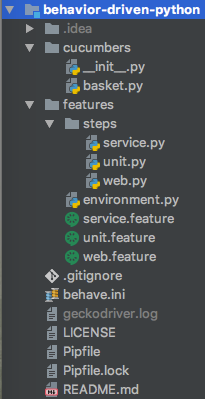Have you heard about behavior-driven development (BDD) and wondered what all the buzz is about? Maybe you've caught team members talking in "gherkin" and felt left out of the conversation. Or perhaps you're a Pythonista looking for a better way to test your code. Whatever the circumstance, learning about BDD can help you and your team achieve better collaboration and test automation, and Python's behave framework is a great place to start.
What is BDD?
In software, a behavior is how a feature operates within a well-defined scenario of inputs, actions, and outcomes. Products can exhibit countless behaviors, such as:
- Submitting forms on a website
- Searching for desired results
- Saving a document
- Making REST API calls
- Running command-line interface commands
Defining a product's features based on its behaviors makes it easier to describe them, develop them, and test them. This is the heart of BDD: making behaviors the focal point of software development. Behaviors are defined early in development using a specification by example language. One of the most common behavior spec languages is Gherkin, the Given-When-Then scenario format from the Cucumber project. Behavior specs are basically plain-language descriptions of how a behavior works, with a little bit of formal structure for consistency and focus. Test frameworks can easily automate these behavior specs by "gluing" step texts to code implementations.
Below is an example of a behavior spec written in Gherkin:
Scenario: Basic DuckDuckGo Search
Given the DuckDuckGo home page is displayed
When the user searches for "panda"
Then results are shown for "panda"At a quick glance, the behavior is intuitive to understand. Except for a few keywords, the language is freeform. The scenario is concise yet meaningful. A real-world example illustrates the behavior. Steps declaratively indicate what should happen—without getting bogged down in the details of how.
The main benefits of BDD are good collaboration and automation. Everyone can contribute to behavior development, not just programmers. Expected behaviors are defined and understood from the beginning of the process. Tests can be automated together with the features they cover. Each test covers a singular, unique behavior in order to avoid duplication. And, finally, existing steps can be reused by new behavior specs, creating a snowball effect.
Python's behave framework
behave is one of the most popular BDD frameworks in Python. It is very similar to other Gherkin-based Cucumber frameworks despite not holding the official Cucumber designation. behave has two primary layers:
- Behavior specs written in Gherkin
.featurefiles - Step definitions and hooks written in Python modules that implement Gherkin steps
As shown in the example above, Gherkin scenarios use a three-part format:
- Given some initial state
- When an action is taken
- Then verify the outcome
Each step is "glued" by decorator to a Python function when behave runs tests.
Installation
As a prerequisite, make sure you have Python and pip installed on your machine. I strongly recommend using Python 3. (I also recommend using pipenv, but the following example commands use the more basic pip.)
Only one package is required for behave:
pip install behaveOther packages may also be useful, such as:
pip install requests # for REST API calls
pip install selenium # for Web browser interactionsThe behavior-driven-Python project on GitHub contains the examples used in this article.
Gherkin features
The Gherkin syntax that behave uses is practically compliant with the official Cucumber Gherkin standard. A .feature file has Feature sections, which in turn have Scenario sections with Given-When-Then steps. Below is an example:
Feature: Cucumber Basket
As a gardener,
I want to carry many cucumbers in a basket,
So that I don’t drop them all.
@cucumber-basket
Scenario: Add and remove cucumbers
Given the basket is empty
When "4" cucumbers are added to the basket
And "6" more cucumbers are added to the basket
But "3" cucumbers are removed from the basket
Then the basket contains "7" cucumbersThere are a few important things to note here:
- Both the Feature and Scenario sections have short, descriptive titles.
- The lines immediately following the Feature title are comments ignored by
behave. It is a good practice to put the user story there. - Scenarios and Features can have tags (notice the
@cucumber-basketmark) for hooks and filtering (explained below). - Steps follow a strict Given-When-Then order.
- Additional steps can be added for any type using
AndandBut. - Steps can be parametrized with inputs—notice the values in double quotes.
Scenarios can also be written as templates with multiple input combinations by using a Scenario Outline:
Feature: Cucumber Basket
@cucumber-basket
Scenario Outline: Add cucumbers
Given the basket has “<initial>” cucumbers
When "<more>" cucumbers are added to the basket
Then the basket contains "<total>" cucumbers
Examples: Cucumber Counts
| initial | more | total |
| 0 | 1 | 1 |
| 1 | 2 | 3 |
| 5 | 4 | 9 |Scenario Outlines always have an Examples table, in which the first row gives column titles and each subsequent row gives an input combo. The row values are substituted wherever a column title appears in a step surrounded by angle brackets. In the example above, the scenario will be run three times because there are three rows of input combos. Scenario Outlines are a great way to avoid duplicate scenarios.
There are other elements of the Gherkin language, but these are the main mechanics. To learn more, read the Automation Panda articles Gherkin by Example and Writing Good Gherkin.
Python mechanics
Every Gherkin step must be "glued" to a step definition, a Python function that provides the implementation. Each function has a step type decorator with the matching string. It also receives a shared context and any step parameters. Feature files must be placed in a directory named features/, while step definition modules must be placed in a directory named features/steps/. Any feature file can use step definitions from any module—they do not need to have the same names. Below is an example Python module with step definitions for the cucumber basket features.
from behave import *
from cucumbers.basket import CucumberBasket
@given('the basket has "{initial:d}" cucumbers')
def step_impl(context, initial):
context.basket = CucumberBasket(initial_count=initial)
@when('"{some:d}" cucumbers are added to the basket')
def step_impl(context, some):
context.basket.add(some)
@then('the basket contains "{total:d}" cucumbers')
def step_impl(context, total):
assert context.basket.count == totalThree step matchers are available: parse, cfparse, and re. The default and simplest marcher is parse, which is shown in the example above. Notice how parametrized values are parsed and passed into the functions as input arguments. A common best practice is to put double quotes around parameters in steps.
Each step definition function also receives a context variable that holds data specific to the current scenario being run, such as feature, scenario, and tags fields. Custom fields may be added, too, to share data between steps. Always use context to share data—never use global variables!
behave also supports hooks to handle automation concerns outside of Gherkin steps. A hook is a function that will be run before or after a step, scenario, feature, or whole test suite. Hooks are reminiscent of aspect-oriented programming. They should be placed in a special environment.py file under the features/ directory. Hook functions can check the current scenario's tags, as well, so logic can be selectively applied. The example below shows how to use hooks to set up and tear down a Selenium WebDriver instance for any scenario tagged as @web.
from selenium import webdriver
def before_scenario(context, scenario):
if 'web' in context.tags:
context.browser = webdriver.Firefox()
context.browser.implicitly_wait(10)
def after_scenario(context, scenario):
if 'web' in context.tags:
context.browser.quit()Note: Setup and cleanup can also be done with fixtures in behave.
To offer an idea of what a behave project should look like, here's the example project's directory structure:

Any Python packages and custom modules can be used with behave. Use good design patterns to build a scalable test automation solution. Step definition code should be concise.
Running tests
To run tests from the command line, change to the project's root directory and run the behave command. Use the –help option to see all available options.
Below are a few common use cases:
# run all tests
behave
# run the scenarios in a feature file
behave features/web.feature
# run all tests that have the @duckduckgo tag
behave --tags @duckduckgo
# run all tests that do not have the @unit tag
behave --tags ~@unit
# run all tests that have @basket and either @add or @remove
behave --tags @basket --tags @add,@removeFor convenience, options may be saved in config files.
Other options
behave is not the only BDD test framework in Python. Other good frameworks include:
pytest-bdd, a plugin forpytest. Likebehave, it uses Gherkin feature files and step definition modules, but it also leverages all the features and plugins ofpytest. For example, it can run Gherkin scenarios in parallel usingpytest-xdist. BDD and non-BDD tests can also be executed together with the same filters.pytest-bddalso offers a more flexible directory layout.radishis a "Gherkin-plus" framework—it adds Scenario Loops and Preconditions to the standard Gherkin language, which makes it more friendly to programmers. It also offers rich command line options likebehave.lettuceis an older BDD framework very similar tobehave, with minor differences in framework mechanics. However, GitHub shows little recent activity in the project (as of May 2018).
Any of these frameworks would be good choices.
Also, remember that Python test frameworks can be used for any black box testing, even for non-Python products! BDD frameworks are great for web and service testing because their tests are declarative, and Python is a great language for test automation.
This article is based on the author's PyCon Cleveland 2018 talk, Behavior-Driven Python.







Comments are closed.